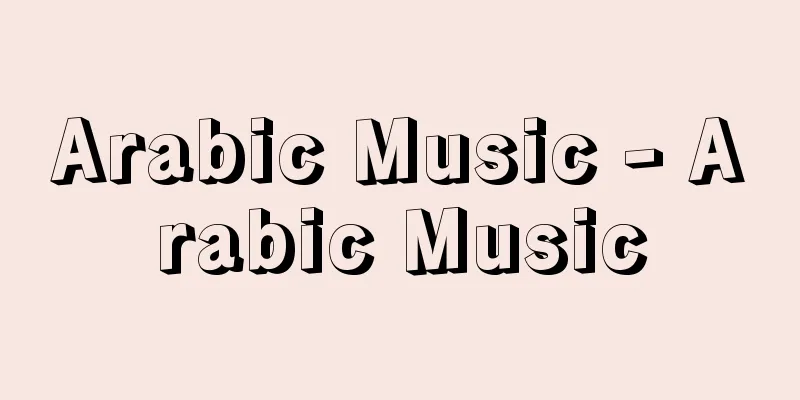Arabic Music - Arabic Music

|
Music of the Arab peoples in the region from Western Asia to North Africa. It mainly refers to classical music performed in Arab countries from Iraq to Morocco, based on a common language, literature, and theoretical system, using almost the same instruments, although there are regional differences. From the perspective of today's performances, Arab music can be broadly divided into two streams: the eastern tradition centered on Egypt, Syria, and Iraq, and the Andalusian tradition of the western (Maghreb) music of Morocco, Algeria, Tunisia, etc. Important features common to both are the mode based on maqam, which includes minute intervals of less than a semitone, and the rhythmic system based on 'iqa, as well as the large-scale multi-movement form unified by combining these with classical Arab poetry. Not much is known about Arab music before Islam. Islam, which began in the 7th century, came into direct contact with the high musical culture of Persia and Byzantium, which came under the Saracen Empire as a result of its conquests, and this promoted the flowering of Arab art music. Great musicians such as Ishaq al-Mawsili were active in Baghdad, the capital of the Abbasid caliphate, and Ziryab in Cordoba, the capital of the Umayyad dynasty in the west. The heyday of the Abbasid dynasty in particular produced philosophers who inherited the arts and sciences of Greece and developed musical theory. The writings of Al-Kindi, Al-Farabi, and Al-Avicenna are particularly important. Baghdad was destroyed by the Ilkhanate in the mid-13th century, and around this time Persian musical theorists such as Safi al-Din, Qutb al-Din, and Abdul Qadir became prominent, and Arab music entered a period of stagnation. After the Ottoman Empire brought most of the Arab world under its control in the 16th century, Turkish music began to be performed at the sultan's court, and Arab classical music in various places was influenced by Turkey and continues to this day. The important forms performed today are the instrumental solo taksim, the ensemble bashraf, and the vocal rayali in the East, and the multi-movement cantata-style nauba (Granada nauba) in the West. Stringed instruments used in classical music include the oud, qanun, rabab, and Western violin, and the vertical flute called nay, the one-headed drum called darbuka, and the tambourine called dukh or tar are also commonly used in Arab countries. The sensual belly dancing of women, which is performed today in nightclubs to the accompaniment of ensembles mainly consisting of these instruments, can also be said to be common to Arab countries. Source: Encyclopaedia Britannica Concise Encyclopedia About Encyclopaedia Britannica Concise Encyclopedia Information |
|
西アジアから北アフリカ一帯におけるアラブ民族の音楽。イラクからモロッコにいたるアラブ諸国で,おのおのの地域的な相違はあるにせよ,共通の言語,文学および理論体系に基づき,ほぼ一様の楽器を用いて行われている古典音楽をおもにいう。今日の演奏からみて,アラブの音楽はエジプト,シリア,イラクを中心とする東方の伝統と,モロッコ,アルジェリア,チュニジアなど西方 (マグレブ) のアンダルース音楽の伝統との2つの流れに大別できる。両者に共通する重要な特徴は,マカームに基づく半音以下の微小音程を含む旋法,およびイーカーに基づくリズム型の体系であり,またその両者とアラブ古典詩の組合せによって統一された大規模な多楽章の形式である。イスラム以前のアラブの音楽についてはあまり知られていない。7世紀に始るイスラムは,その征服事業の結果サラセン帝国の版図に入ったペルシアやビザンチンの高い音楽文化とじかに接することになり,アラブの芸術音楽の開花を促すことになる。アッバース朝カリフの都バグダードではイスハーク・アルマウシリー,西のウマイヤ朝の都コルドバではジルヤーブのごとき大音楽家が活躍した。特にアッバース朝全盛期には,ギリシアの諸学芸を受継ぎ音楽理論を展開させた哲学者が輩出した。とりわけキンディー,ファーラービー,アビセンナらの著述は重要である。 13世紀中葉にバグダードはイル・ハン国に滅ぼされるが,この頃にはサフィー・ウッディーン,クトゥブ・ウッディーン,アブダル・カーディルらペルシア系の音楽理論家の活躍が目立ち,以後アラブ音楽は停滞期に入る。 16世紀にオスマン帝国がアラブ世界の大半をその支配下に入れてからは,スルタンの宮廷でトルコ音楽が行われるようになり,各地のアラブの古典音楽はトルコの影響を受けて今日にいたる。今日演奏される重要な形式は,東方では楽器独奏のタクシーム,合奏のバシュラフ,声楽のラヤーリーなど,また西方では多楽章のカンタータ風のナウバ (グラナダのナウバ) である。古典音楽に用いられる弦楽器には,ウード,カーヌーン,ラバーブ,西洋のバイオリンなどがあり,ナーイという縦笛,ダラブッカという片面鼓,ドゥッフまたはタールと呼ばれるタンブリンもアラブ諸国に共通して用いられる。また,これらの楽器を主体とする合奏の伴奏で,今日各地のナイトクラブで行われる官能的な女性のベリー・ダンスもアラブ諸国に共通なものといえる。
出典 ブリタニカ国際大百科事典 小項目事典ブリタニカ国際大百科事典 小項目事典について 情報 |
<<: United Arab Emirates - Arab Emirates (English spelling)
Recommend
Great Indian Plains
…The word Hindustan comes from the Persian word f...
Census - Sensasu (English spelling) census
A census is a survey conducted by a government or...
Diabetes in children and adolescents
What is the disease? This is diabetes that develo...
Bamboccianti (English spelling)
A general term for genre painters, mainly from the...
Garden of Gethsemane - Gethsemane
Gethsemane means "olive oil press" in He...
Red mouth - Akaokuchi
〘Noun〙 Scarlet large-mouthed hakama (trousers) . R...
Knox Coast
…Later, the names of the captains were given to t...
Oohime (English spelling) Crimson jobfish
A marine fish belonging to the order Perciformes ...
Popular songs of the color village - Popular songs of the color village
...Starting with Takatatsu-bushi, around the Kan&...
Festspielhaus Bayreuth (English spelling)
…Premiere of R. Strauss's Die Frau ohne Schat...
VITA-Parcours (English) VITAParcours
...Field athletics is a Japanese-English word tha...
Isabel Style - Isabel Style
The name of the Spanish Late Gothic style, named a...
Ontology
…The term goes back to the Latin ontologia, or ph...
Mystery of the Universe
…He continued to search tirelessly for mathematic...
The Five Great Kings
A Myo-o-sect deity consisting of a set of four gr...









